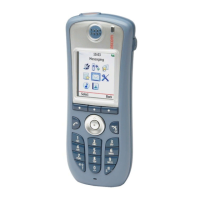TD 92685EN
28 June 2012 / Ver. A
Troubleshooting Guide
Ascom i62 VoWiFi Handset
20
3. The VoWiFi Handset as
The regulations for using 5 GHz channels, generally known as DFS channels, in which radar
operates, is that the handset uses a different approach while scanning.
The DFS regulations require that WiFi devices should check for radar that i
s currently
operating before they initiate a session. This requires special software features and is
normally only included in APs, which are the devices that are set to use a specific channel. If
a radar signal is detected the AP should invoke a special procedure to automatically move to
another channel. During this transfer to another channel, which takes a while, the
transmission of packets in that cell is stopped and as a result the call can be lost.
Portable devices, like a handset, are not able to de
tect radar and thus are not allowed to
initiate a conversation. Active probing on the DFS channels is therefore prohibited until is
has been determined that no radar is present.
To detect an AP to roam to, the handset has to use pas
sive scanning which means it has to
listen to beacons on every configured channel.
The default beacon period in most APs is set 102.4ms. Using a short scanning interval of
let'
s say 20ms on a channel the handset’s chances of hearing a beacon is about one in five.
To improve the chances of the handset picking up a beacon the listening time on a channel
can be extended or the beacon period made shorter.
For the DFS channels the passive listening time for the handse
t is set to 70ms, during which
the handset may or may not hear a beacon. If the handset hears a beacon during this period
or if the time period expires, it will immediately return to its currently working channel and
exchange packets with the current AP that was buffered during the scanning process.
If the handset did hear a beacon it will do active probing on that channel and add the APs it
h
ears to the roaming table. It will then go on with this process with the next channel it is set
up to use. When it gets to the current channel it can immediately do a probe request to find
any other APs on that channel to add to the roaming table.
Note: S
ince scanning for many channels takes a considerable time, it is important that the
channels used in the scanning process are only those channels that have been setup for use
in the WLAN system.
After finalizing the first round it wi
ll decide whether to roam or not, and which AP to use.
For optimal voice performance it is not recommende
d to use DFS channels. If they are used
limit the number of channels to 8 otherwise roaming will be further degraded.
3.8 SIP
Session Initiation Protocol (SIP) is an application layer signaling protocol defined in the IETF
standard RFC3261. It is used to setup, control and manage sessions between two or more
endpoints in an IP based network. These sessions include Internet telephone calls,
multimedia distribution, and multimedia conferences that use TCP, TLS/TCP or UDP for
transport.
SIP is a fairly loose standard and t
he implementation is up to the manufacturer of the
handset. Since each implementation may have some vendor specific code it is important
that the handset is used together with a SIP-Proxy (IP-PBX) that is tested by the
interoperability team. Only those solutions that have been tested are supported by Ascom
wireless.
When troubleshooting VoIP in a handset a sol
id understanding of how a SIP session is
established between two phones and where the voice packets are going will speed up the
troubleshooting process.

